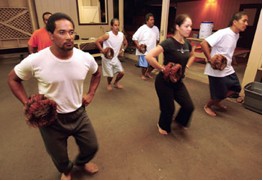Dance: Inmates I Mua
Prisoner-dancers take their first steps forward after losing a kumu hula.
Honolulu Magazine
November 2005
By Ilima Loomis
The dancers treasure the three hours a week when they can soak up lessons of tradition and discipline within their hula family. photo: Matt Thayer For the dancers of Halau Na Pa'ahau Maoli, it was like losing a mother. Kumu hula Debbie Kamalii had started the Hawaiian culture program at Maui Community Correctional Center three years earlier and watched it grow into a hula halau of more than 20 men and women. For some inmates, she was the closest thing to family; others knew her as a taskmaster, who pushed them hard both on and off the dance floorŠand they loved her for it.
Then one sunny morning in May, Kamalii checked into Maui Memorial Medical Center with a painful scratch on her thigh. Ten hours later, she was dead of a catastrophic infection.
"It was a big shock," says Jonah Souza, 22. "Plenty guys, they never had the heart fo' dance anymore." The halau was reeling. Just weeks away from a big performance, still learning dances more difficult than they'd ever tried, the inmates received special permission from MCCC to attend Kamalii's memorial, even as they wondered how the halau could ever continue without her.
But the program's umbrella organization, Maui Economic Opportunity, was already looking for a way to carry on Kamalii's work.
"There was no way it was going to stop," says Verdine Kong, in charge of developing new arts and culture programs for prisoner reintegration programs. A dancer herself, Kong started by recruiting her own teacher, Ualani Smith, who stepped in to supervise rehearsals and help the halau perfect the last dances they had learned from their mentor. Smith planned to stay a few weeks, until a permanent replacement was found. By the time MEO advertised for the job, she was ready to apply.
Smith was impressed by the inmates' commitment to the program, coming to three-hour classes after sweating all day on the MCCC workline, and making time to practice even within the restrictions of prison: dancing in their dorms before bed or walking across the prison yard.
"'Practice' is a hard word when you're incarcerated," Smith says. "I told them, 'dream about it.'"
"This kind of brings me back to the center," says Kainoa Wilhelm, 31, who said embracing the Hawaiian concept of 'pono,' or doing right, helped him stay focused and positive as he completed eight years behind bars.
Permitted to attend events around Maui with minimal supervision, from private fund-raisers to the local mall, dancing in public became a precious chance to show the community a reason to be proud. (The inmates in the halau generally have a higher level of privileges and are participating in reintegration programs.)
"They think we come in here and get more affiliated with gangs and drugs and stuff. But there is something positive we get out of jail," says Richard Kauvaka, 26.
While the program has been an introduction to hula for many, a few, like Souza, were once serious dancers. "It took coming into prison to get me to go back to hula again," he says. "I love it. I always did. I wish I never stopped."
At a men's rehearsal in Wailuku, Smith coached her group through a traditional kahiko, before easing them into a slower 'auana. As they softened their hands, Smith talked them through the bittersweet tune, about a man who had strayed from his family and longed to come home.
As he danced, Dedrick Rittmeister, 41, mouthed the lyrics–a lonely path, a sad heart, a hoped-for embrace.
"It's prodigal son kine stuff," he explains. "The prodigal son. That's what my mother calls me."
